Painting Materials and Technique for the Expression of Chinese Inheritance in Liu Kang’s Huangshan and Guilin Landscapes (1977–1996)
Abstract
1. Introduction
2. Materials and Methods
2.1. Materials
2.2. Methods
2.2.1. Technical Photography
2.2.2. Digital Microscopy
2.2.3. XRR
2.2.4. Preparation of Samples
2.2.5. OM and PLM
2.2.6. Staining Tests
2.2.7. FE-SEM-EDS
2.2.8. ATR-FTIR
3. Results and Discussion
3.1. Characteristics of the Painting Supports
3.2. Characteristics of the Grounds
3.3. Liu Kang’s Paint Brands and Palette of Colours
3.3.1. Brown
3.3.2. Yellow and Orange
3.3.3. Blue
3.3.4. Green
3.3.5. White and Black
3.4. Binding Media and Other Identified Compounds
3.5. Sketches, Drawings, Photographs and Preparatory Underdrawings
3.6. Development of Paintings
3.7. Artist’s Practice of Reusing Earlier Paintings
3.8. Provenance of the Paintings
4. Conclusions
Author Contributions
Funding
Institutional Review Board Statement
Informed Consent Statement
Data Availability Statement
Acknowledgments
Conflicts of Interest
Appendix A
| Title and Inventory Number | Date | Colour | Sample | SEM-EDS * Detected Elements | PLM, SEM-EDS Tentative Assignments | FTIR Identification |
|---|---|---|---|---|---|---|
| Mountain, 2003-03246 | 1977 | Brown | 3 | C, O, Ca, Zn, Ti, Ba, S, Fe, Na, (Si, P, Al, Pb, Mg, Cl, Sr) | Lithopone and/or barium white and zinc white, titanium white, red iron-rich earth pigment, bone black, lead white | |
| Brown | 4 | C, O, Fe, Si, Ca, S, (Cl, Pb, Sr, P, Ba, Na, Zn, Cr, Sn, Al, Ti) | Red iron-rich earth pigment, bone black, lithopone and/or barium white and zinc white, Cr-containing yellow(s), organic red on Sn and/or Al-containing substrate, titanium white | Lithopone and/or barium white and zinc white, iron-rich earth pigment, bone black, naphthol red AS-D, oil | ||
| Blue | 5 | C, O, Na, Al, Si, S, Ca, (Sr, Zn, Mg, K, Ti, Fe) | Ultramarine, chalk, zinc white, titanium white | |||
| Blue | 7 | C, O, Ca, Zn, Ti, Ba, S, Na, (Al, P, Mg, Fe, Si) | Lithopone and/or barium white and zinc white, titanium white, ultramarine, bone black | |||
| Blue | 9 | C, O, Ca, Zn, Ti, Ba, S, Na, (Al, Pb, Mg, Si, Cl) | Chalk, lithopone and/or barium white and zinc white, titanium white, ultramarine, lead white | |||
| Green | 1 | C, O, Cr, Zn, Ba, K, Na, (S, Al, Ca, Mg, Si, Ti, Cl, Fe, P) | Viridian, lithopone and/or barium white and zinc white, bone black, titanium white, Prussian blue | Viridian, lithopone and/or barium white and zinc white, zinc yellow, zinc soap, oil | ||
| White | 8 | C, O, Ca, Zn, Ti, Ba, S, Na, (Mg, Si, Al, P) | Lithopone and/or barium white and zinc white, titanium white, ultramarine, bone black | |||
| Mountain, 2003-03313 | 1981 | Brown | 8 | C, O, Ba, S, Al, Zn, Na, Sr, Si, Fe, (Pb, Ca, P) | Lithopone and/or barium white and zinc white, ultramarine, yellow iron-rich earth pigment, lead white, bone black | Lithopone and/or barium white and zinc white, bone black, zinc soap, oil |
| Yellow | 7 | O, C, Ba, Zn, Ti, Ca, Cr, S, Fe, Si, Al, Na, (Mg, P, Pb, K) | Lithopone and/or barium white and zinc white, titanium white, chalk, viridian, yellow iron-rich earth pigment, bone black | Lithopone and/or barium white and zinc white, chalk, Hansa Yellow G, viridian, yellow iron-rich earth pigment, zinc soap, oil | ||
| Blue | 4 | C, O, Zn, Ca, Ba, Ti, S, Pb, Na, Al, (Si, Mg, Cd, Cl, Fe, P, Sr, Cr) | Lithopone and/or barium white and zinc white, titanium white, lead white, ultramarine, cadmium yellow or its variant, bone black | |||
| Blue | 6 | Zn, C, O, Na, (Al, Si, Ba, S, Ti, Ca) | Lithopone and/or barium white and zinc white, ultramarine, titanium white, chalk | |||
| Green | 3 | C, O, Zn, Ca, Ba, Cd, Na, S, (Cl, Si, Mg, Al) | Lithopone and/or barium white and zinc white, chalk, cadmium yellow or its variant, ultramarine | Lithopone and/or barium white and zinc white, chalk, zinc soap, oil | ||
| Green | 9 | C, O, Pb, Ba, Zn, Al, S, Cr, Si, Fe, (Na, Ti, Ca, Cl, Mg) | Lead white, lithopone and/or barium white and zinc white, ultramarine, viridian, chalk | |||
| White | 5 | C, O, Ba, Ti, S, Zn, Al, (Na, Si, Ca, Sr, P) | Lithopone and/or barium white and zinc white, titanium white, ultramarine, bone black | |||
| Mount Huangshan, 2003-03304 | 1983 | Brown | 3 | Zn, C, O, Na, Fe, Ba, S, (Cr, Al, Si, K, Pb, Ti) | Lithopone and/or barium white and zinc white, red iron-rich earth pigment, Cr-containing yellow, organic red, lead white, titanium white | Lithopone and/or barium white and zinc white, naphthol red AS-D, zinc soap, oil |
| Brown | 6 | Zn, C, O, Na, Cr, Ba, K, (S, Al, Fe, Si, Pb, Cl, Ti) | Lithopone and/or barium white and zinc white, Cr-containing yellow(s), ultramarine, red iron-rich earth pigment, titanium white | |||
| Blue | 2 | C, O, Ba, Ca, Zn, S, Al, Na, Ti, (Pb, Si, Mg, Cl) | Lithopone and/or barium white and zinc white, chalk, ultramarine, titanium white, lead white | |||
| Green | 4 | Zn, C, O, Ba, Cl, Na, Al, S, Si, (Cr, Fe, Mg, Cu, K, Pb, Sr, Ca) | Lithopone and/or barium white and zinc white, phthalocyanine green, Prussian blue, lead white, chalk | Lithopone and/or barium white and zinc white, phthalocyanine green, Prussian blue, zinc soap, oil | ||
| Green | 5 | C, O, Zn, Ba, Al, S, Na, Cl, Ti, (Si, Ca, Pb, Sr, Mg, Fe) | Lithopone and/or barium white and zinc white, ultramarine, titanium white, chalk, lead white | Lithopone and/or barium white and zinc white, phthalocyanine green, ultramarine, zinc soap, oil | ||
| White | 1 | Zn, C, O, Na, Ti, Ca, (Ba, Fe, Al, Si, S) | Lithopone and/or barium white and zinc white, titanium white, chalk, ultramarine, yellow iron-rich earth pigment | |||
| Mount Huangshan, 2003-03327 | 1986 | Brown | 5 | C, O, Zn, Fe, Ti, Ca, Na, Mg, Si, Al, (P, Sr, S, Mn) | Zinc white, red iron-rich earth pigment, titanium white, organic red on Al-containing substrate, umber, bone black | Red iron-rich earth pigment, organic red, chalk, zinc soap, oil |
| Blue | 2 | C, Zn, O, Na, Al, S, Ba, Ti, Si, (Ca, Fe, Cl, K) | Lithopone and/or barium white and zinc white, ultramarine, titanium white, chalk, Prussian blue | |||
| Blue | 7 | C, O, Al, Zn, Co, Ca, Si, Na, (Mg, S, Fe, Cu, Ti, Cl, Pb, Cr, P) | Ultramarine, zinc white, cobalt blue, phthalocyanine blue, titanium white, viridian, lead white, bone black | Phthalocyanine blue, cobalt blue, chalk, zinc soap, oil | ||
| Green | 3 | C, O, Zn, Ca, Na, Ba, S, Si, Fe, (Al, Cl, Mg, Ti) | Lithopone and/or barium white and zinc white, chalk, ultramarine, yellow iron-rich earth pigment, titanium white | |||
| Green | 4 | C, O, Fe, Ca, Si, Al, Ba, S, Cl, (Ti, Zn, Mg, Cu) | Yellow iron-rich earth pigment, chalk, lithopone and/or barium white and zinc white, titanium white, phthalocyanine green | Yellow ochre, lithopone and/or barium white and zinc white, chalk, phthalocyanine green, zinc soap, oil | ||
| White | 6 | C, O, Ti, Zn, Ca, Mg, Al, Na, (Fe, S, Si, Cl) | Titanium white, zinc white, chalk, ultramarine, yellow iron-rich earth pigment | |||
| Mount Huangshan, 2003-03251 | 1987 | Brown | 4 | C, O, Fe, Al, Si, Na, S, Ca, Ba, (P, Ti, Mn, Zn, Mg, Pb, K, Cl) | Umber, bone black, lithopone and/or barium white and zinc white, titanium white, lead white | Umber, lithopone and/or barium white and zinc white, oil |
| Blue | 2 | C, O, Ti, Zn, Ca, Mg, Al, Na, (S, Si, Fe, Cl) | Titanium white, zinc white, chalk, ultramarine, Prussian blue | |||
| Blue | 5 | O, Zn, Ba, C, S, Na, Al, Ti, Si, Ca, (Mg, Fe, Cl, Sr, K, Pb) | Lithopone and/or barium white and zinc white, titanium white, ultramarine, lead white | Lithopone and/or barium white and zinc white, ultramarine, chalk, oil | ||
| Green | 3 | C, O, Na, Al, S, Cl, Ti, Zn, Ba, (Fe, Ca, Si, Sr, Pb, Cu) | Ultramarine, lithopone and/or barium white and zinc white, titanium white, yellow iron-rich earth pigment, chalk, lead white, phthalocyanine green, lead white | |||
| Green | 7 | C, O, Zn, Ca, Na, S, Ti, Fe, Al, Si, (Ba, Mg, Cl, K) | Lithopone and/or barium white and zinc white, chalk, ultramarine, titanium white, yellow iron-rich earth pigment | |||
| White | 6 | C, O, Ti, Zn, Ca, Al, Mg, Na, (S, Si, Fe, Cl) | Titanium white, zinc white, chalk, ultramarine, yellow iron-rich earth pigment | |||
| Mountains, 2003-03306 | 1991 | Brown | 6 | C, O, Zn, Ti, Fe, Ca, Na, Ba, Al, Mg, (Si, S, Pb, P) | Lithopone and/or barium white and zinc white, titanium white, red and yellow iron-rich earth pigment, lead white, bone black | |
| Blue | 1 | C, O, Zn, Ca, Na, Ti, (Mg, Al, Ba, Si, Pb, S) | Lithopone and/or barium white and zinc white, chalk, titanium white, ultramarine, lead white | |||
| Violet | 5 | C, O, Zn, Ti, Ba, Al, Ca, Na, Si, S, (Mg, Fe, Pb) | Lithopone and/or barium white and zinc white, titanium white, chalk, ultramarine, yellow iron-rich earth pigment, lead white | |||
| Green | 8 | C, O, Ca, Zn, S, Na, (Si, Cl, Mg, Al, Fe, Ti) | Chalk, zinc white, ultramarine, yellow iron-rich earth pigment, titanium white | Yellow iron-rich earth pigment, Hansa yellow G, chalk, zinc soap, oil | ||
| Green | 9 | C, O, Ca, Zn, S, Na, (Cl, Si, Mg, Fe, Al, Ba) | Chalk, lithopone and or barium white and zinc white, ultramarine, yellow iron-rich earth pigment | Chalk, yellow iron-rich earth pigment, Hansa yellow G, zinc soap, oil | ||
| Green | 10 | C, O, Ca, Zn, Fe, S, Ba, Si, Cl, Al, (Ti, Na, Mg, Cu, Pb) | Chalk, lithopone and/or barium white and zinc white, yellow iron-rich earth pigment, ultramarine, titanium white, phthalocyanine green, lead white | Chalk, lithopone and/or barium white and zinc white, yellow iron-rich earth pigment, phthalocyanine green, Hansa yellow G, zinc soap, oil | ||
| Grey | 4 | C, O, Ti, Zn, Ca, Ba, Al, Mg, (Na, S, Si, Fe) | Titanium white, lithopone and/or barium white and zinc white, chalk, ultramarine, yellow iron-rich earth pigment | |||
| Mount Huangshan, 2003-03376 | 1993 | Brown | 6 | C, O, Zn, Ti, Fe, Na, Ca, Al, Mg, Si, (S, P) | Zinc white, titanium white, yellow and red iron-rich earth pigment, bone black | |
| Brown | 7 | O, C, Fe, Zn, Ca, Si, Al, Na, P, Mg, Ti, (Mn, Pb, Sr, S, Cl, K) | Yellow and red iron-rich earth pigment, umber, bone black, titanium white, lead white | |||
| Yellow | 4 | C, O, Ca, Ba, Cd, S, Zn, (Fe, Si, Al, Na, Mg, Cl, Ti, Pb) | Lithopone and/or barium white and zinc white, chalk, cadmium yellow or its variant, yellow iron-rich earth pigment, titanium white, lead white | |||
| Blue | 2 | C, O, Zn, Na, Ti, Ca, Al, Co, (Mg, Si, Fe, S) | Zinc white, ultramarine, titanium white, chalk, cobalt blue, yellow iron-rich earth pigment | Ultramarine, cobalt blue, chalk, zinc soap, oil | ||
| Blue | 8 | C, O, Ti, Ca, Zn, Cr, Al, Pb, Mg, (Si, Na, Co, S) | Titanium white, chalk, zinc white, viridian, lead white, ultramarine, cobalt blue | |||
| Green | 5 | C, O, Cr, Zn, Ca, Ba, Ti, Fe, Si, Al, S, (Mg, Cd, P, Cl) | Viridian, lithopone and/or barium white and zinc white, titanium white, yellow iron-rich earth pigment, cadmium yellow or its variant, bone black | |||
| Grey | 3 | C, O, Ti, Zn, Ca, Al, Mg, (Na, S, Pb, Si) | Titanium white, zinc white, chalk, ultramarine, lead white | |||
| Mount Huangshan, 2003-03307 | 1994 | Brown | 4 | C, O, Ti, Fe, Zn, Ca, Mg, Al, (Na, Si, S, Pb, P) | Titanium white, yellow and red iron-rich earth pigment, zinc white, bone black, ultramarine, lead white | Iron-rich earth pigment, chalk, zinc soap, oil |
| Brown | 6 | C, O, Fe, Ca, Si, Ti, Ba, S, Al, (Zn, Mg, P, Sr, Cl, Pb) | Red iron-rich earth pigment, bone black, lithopone and/or barium white and zinc white, lead white | |||
| Yellow (yellow cluster) | 7 | C, O, Fe, Ca, Zn, (Na, Mg, Si, S, Al) | Yellow iron-rich earth pigment, chalk, zinc white | |||
| Yellow (green cluster) | C, O, Fe, Ca, Zn, Al, (Si, Ti, Mg, S, Co, Ba, Cl) | Yellow iron-rich earth pigment, lithopone and/or barium white and zinc white, chalk, ultramarine, Co-containing pigment | ||||
| Blue | 2 | C, O, Ti, Zn, Ca, Al, Ba, Mg, Co, (Si, Na, S) | Titanium white, lithopone and/or barium white and zinc white, chalk, ultramarine, cobalt blue | Lithopone and/or barium white and zinc white, chalk, ultramarine, cobalt blue, zinc soap, oil | ||
| Green | 3 | C, O, Ca, Al, Ti, Cr, Zn, Si, (Fe, Mg, Co, Cl, Na, Sr, S, Pb, P) | Ultramarine, titanium white, viridian, zinc white, cobalt blue, yellow iron-rich earth pigment, lead white, bone black | Chalk, ultramarine, viridian, cobalt blue, chalk, zinc soap, oil | ||
| Green | 5 | C, O, Zn, Fe, Na, (Cl, Ca, Al, Si, Ti, S) | Zinc white, yellow iron-rich earth pigment, ultramarine, chalk, titanium white | |||
| Grey | 1 | C, O, Zn, Ti, Na, Ca, Mg, Al, (S, Si, Co, Fe) | Zinc white, titanium white, chalk, ultramarine, cobalt blue contamination, yellow iron-rich earth pigment | |||
| Mount Huangshan, 2003-03378 | 1995 | Brown | 8 | C, O, Zn, Ca, Na, Fe, Si, (P, Al, Mg, S, Ti, Cr, Mn, Ba, K, Cl) | Lithopone and/or barium white and zinc white, bone black, umber, titanium white, Cr-containing yellow pigment, titanium white | |
| Blue | 1 | C, Zn, O, Al, Ca, Co, Na, (Ti, Mg, Si, S, Ba) | Lithopone and/or barium white and zinc white, chalk, ultramarine, cobalt blue, titanium white | Chalk, ultramarine, cobalt blue, oil | ||
| Blue | 2 | C, O, Zn, Ti, Ba, Ca, Al, Na, Mg, (Cr, Si, S, Fe) | Lithopone and/or barium white and zinc white, titanium white, chalk, ultramarine, viridian | |||
| Violet | 5 | C, O, Zn, Ti, Ca, Fe, Ba, Al, Si, Mg, (Na, P, S, K) | Lithopone and/or barium white and zinc white, titanium white, red iron-rich earth pigment, ultramarine, bone black | |||
| Green | 3 | C, O, Zn, Fe, Na, Ca, (Ti, Al, Ba, Cl, Si, Mg, S) | Lithopone and/or barium white and zinc white, chalk, titanium white, ultramarine, yellow iron-rich earth pigment, chalk | Hansa yellow G, yellow iron-rich earth, chalk, oil | ||
| Green | 4 | C, O, Cr, Ca, Ba, Zn, Si, (Al, S, Mg, Na, Cl, Ti, Fe, K) | Viridian, chalk, lithopone and/or barium white and zinc white, titanium white, yellow iron oxide | |||
| Grey | 7 | C, O, Ti, Zn, Ba, Ca, Al, Mg, (Na, Fe, S, Pb, Si, Cr) | Titanium white, lithopone and/or barium white and zinc white, chalk, ultramarine, yellow iron-rich earth pigment, viridian, lead white | |||
| Mountain, 2003-03293 | 1995 | Brown | 5 | C, O, Ti, Fe, Ca, Zn, Al, (Mg, Na, Si, S, P) | Titanium white, yellow iron-rich earth pigment, bone black, zinc white | Chalk, yellow iron-rich earth pigment, bone black, zinc soap, oil |
| Brown | 8 | O, C, Fe, Ca, Si, P, Al, Mg, Mn, Zn, (Na, S, K, Ti, Sr, Pb, Cl) | Red iron-rich earth pigment, umber, bone black, zinc white, titanium white, lead white | |||
| Blue | 3 | C, O, Zn, Ti, Ca, Na, Mg, (Al, Cr, S, Si, Cl, Pb) | Zinc white, titanium white, chalk, ultramarine, viridian, lead white | |||
| Green | 6 | C, O, Zn, Ti, Ca, Cr, Na, Fe, Al, (Mg, Si, S, Cl, Sr) | Zinc white, titanium white, chalk, viridian, yellow iron-rich earth pigment | |||
| Green | 7 | C, O, Cr, Ca, Ba, Si, Al, Zn, Ti, (S, Na, Mg, Cl) | Viridian, chalk, lithopone and/or barium white and zinc white, titanium white | Viridian, chalk, lithopone and/or barium white and zinc white, Hansa yellow G, oil | ||
| Grey | 4 | C, O, Ti, Zn, Ca, Al, Mg, (Na, Co, S, Cr, Si, Fe) | Titanium white, zinc white, chalk, ultramarine, viridian, Co-containing pigment, yellow iron-rich earth pigment | |||
| Mount Huangshan, 2003-03257 | 1996 | Brown | 8 | C, O, Zn, Ba, Fe, Pb, Ca, S, Na, Al, (Si, Cr, Cl, P, Sr, Mg) | Lithopone and/or barium white and zinc white, Prussian blue, Cr-containing yellow(s), organic red on Al-containing substrate, ultramarine, bone black | Lithopone and/or barium white and zinc white, Prussian blue, chrome yellow, yellow iron-rich earth pigment, organic red, bone black, zinc soap, oil |
| Yellow | 7 | C, O, Fe, Ca, Ba, Cd, S, Zn, (Cl, Sn, Mg, Na, Al, Si) | Yellow iron-rich earth pigment, chalk, lithopone and/or barium white and zinc white, cadmium yellow or its variant, organic red on Sn-containing substrate | Yellow iron-rich earth pigment, lithopone and/or barium white and zinc white, cadmium yellow or its variant, naphthol red AS-D, oil | ||
| Blue | 2 | C, O, Ti, Zn, Ca, Na, (Fe, Si, Mg, Pb, Al, S, P, Cl) | Titanium white, zinc white, chalk, yellow iron-rich earth pigment, lead white, ultramarine, bone black | |||
| Blue | 3 | C, O, Ti, Zn, Ca, Ba, Fe, Al, Mg, (S, Si, Cl, Cr, Na, Pb) | Titanium white, lithopone and/or barium white and zinc white, chalk, Prussian blue, ultramarine, viridian, lead white | |||
| Green | 5 | C, O, Zn, Ca, S, Na, Ba, (Mg, Cl, Al, Si, Sr, P, Ti) | Lithopone and/or barium white and zinc white, ultramarine, bone black, titanium white | Lithopone and/or barium white and zinc white, chalk, Hansa yellow G, ultramarine, yellow iron-rich earth pigment, zinc soap, oil | ||
| Green | 6 | C, O, Zn, Ba, Pb, S, Fe, Cr, Na, Ca, (Al, Si, P, Mg, Cl, K) | Lithopone and/or barium white and zinc white, chrome yellow, Prussian blue, bone black | Lithopone and/or barium white and zinc white, chrome yellow, Prussian blue, chalk, zinc soap, oil | ||
| Grey | 4 | O, C, Ti, Zn, Ca, Ba, Na, (Mg, Si, P, Al, Pb, S) | Titanium white, lithopone and/or barium white and zinc white, ultramarine, bone black, lead white |

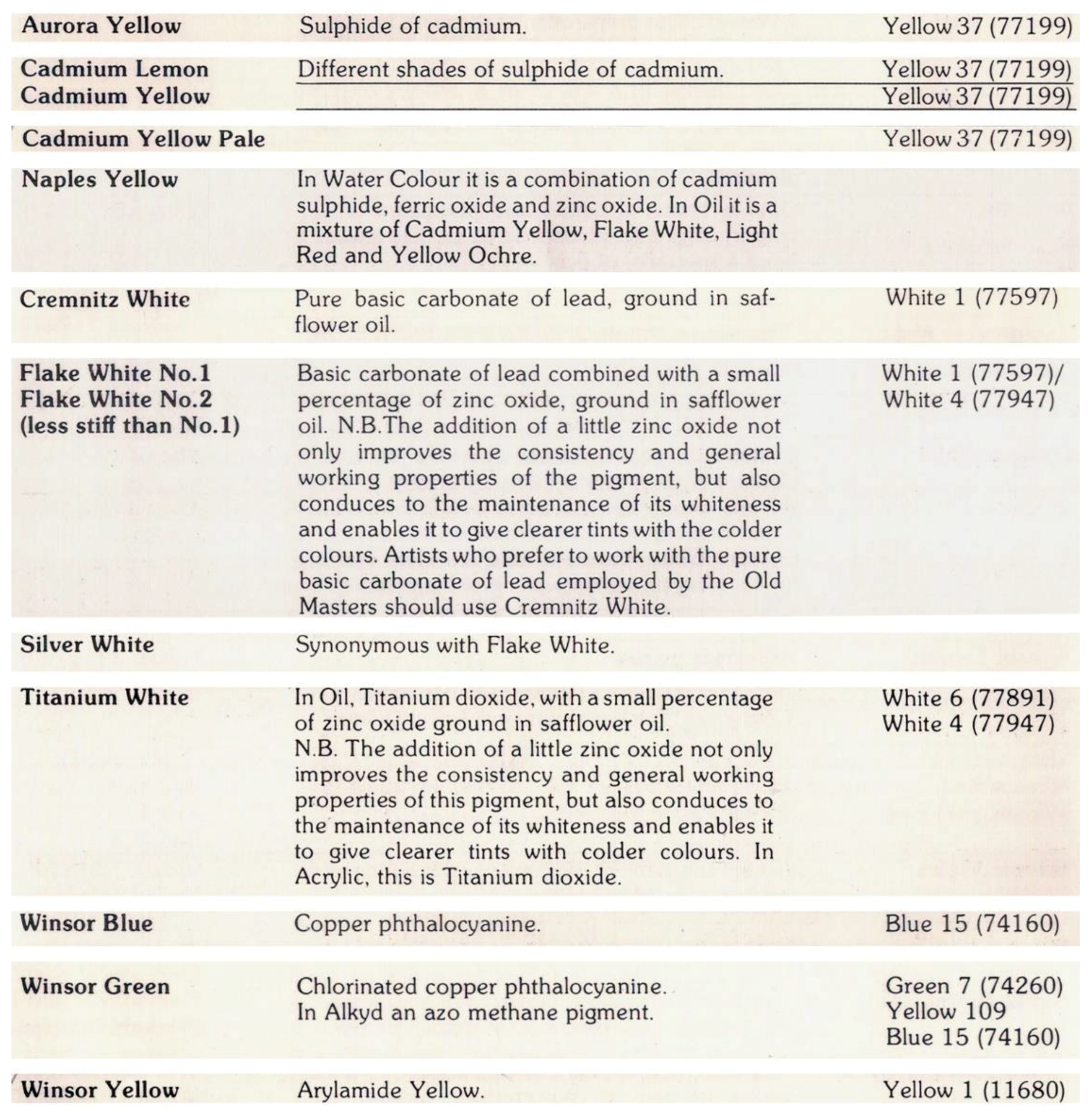

References
- Chow, K.K.; Sen, G.; Mo, Z. Journeys: Liu Kang and His Art; National Arts Council: Singapore, 2000; pp. 49, 57, 93.
- Yow, S.K. A Chinese scholar in Singapore: 1961–1980. In Liu Kang: Essays on Art and Culture; Siew, S., Ed.; National Art Gallery: Singapore, 2011; p. 89. [Google Scholar]
- Sabapathy, T.K. The Nanyang artists: Some general remarks. In Pameran Retrospektif Pelukis-Pelukis Nanyang. Muzium Seni Negara Malaysia, 26hb Oktober–23hb Disember 1979; Muzium Seni Negara Malaysia: Kuala Lumpur, Malaysia, 1979; pp. 43–48. [Google Scholar]
- Sabapathy, T.K. Forty years and after: The Nanyang artists. Remarks on art and history. In New Directions 1980–1987: Modern Paintings in Singapore; Thang, K.H., Ed.; Horizon Publishing: Singapore, 1987; p. 6. [Google Scholar]
- Ong, E. The Nanyang artists: Eclectic expressions of the South Seas. In Imagining Identities: Narratives in Malaysian Art; Khairuddin, N.H., Yong, B., Sabapathy, T.K., Eds.; Rogue Art: Kuala Lumpur, Malaysia, 2012; Volume 1, pp. 59–70. [Google Scholar]
- Lizun, D.; Kurkiewicz, T.; Mądry, M.; Szczupak, B. The emergence of Liu Kang’s new painting style (1950–1958): A multi-analytical approach for the study of the artist’s painting materials and technique. Herit. Sci. 2022, 10, 16. [Google Scholar] [CrossRef]
- Wai Hon, C. Liu Kang at 87. In Liu Kang at 87; Han Wue, T., Ed.; National Arts Council: Singapore; National Heritage Board: Singapore, 1997; p. 23. [Google Scholar]
- Noi, T.G.; Sin Weng Fong, S. (Eds.) Liu Kang at 88—the Man and his Art. In Liu Kang at 88; Singapore Soka Association: Singapore, 1998; p. 24. [Google Scholar]
- Hoe, H.K. Liu Kang. Singap. Artist. 1955, 1, 15. [Google Scholar]
- Liu, K. Fu Lei and Fu Ts’Ong. In Liu Kang: Essays on Art and Culture; Siew, S., Ed.; National Art Gallery: Singapore, 2011; p. 128. [Google Scholar]
- Mahbubani, G. Journey of a pioneer artist. The Straits Times, 1 December 1981; 1. [Google Scholar]
- Liu, K. I am eighty-seven. In Liu Kang at 87; Han Wue, T., Ed.; National Arts Council: Singapore; National Heritage Board: Singapore, 1997; p. 27. [Google Scholar]
- Lizun, D.; Kurkiewicz, T.; Szczupak, B. Exploring Liu Kang’s Paris practice (1929–1932): Insight into painting materials and technique. Heritage 2021, 4, 828–863. [Google Scholar] [CrossRef]
- Lizun, D. A preliminary study of Liu Kang’s palette and the discovery and interpretation of hidden paint layers. Herit. Sci. 2020, 8, 21. [Google Scholar] [CrossRef]
- Lizun, D.; Kurkiewicz, T.; Szczupak, B. Technical examination of Liu Kang’s Paris and Shanghai painting supports (1929–1937). Herit. Sci. 2021, 9, 37. [Google Scholar] [CrossRef]
- Lizun, D.; Kurkiewicz, T.; Mądry, M.; Szczupak, B.; Rogóż, J. Evolution of Liu Kang’s palette and painting practice for the execution of female nude paintings: The analytical investigation of a genre. Heritage 2022, 5, 896–935. [Google Scholar] [CrossRef]
- Sullivan, F. Liu Kang—His art and life. In Liu Kang; Liu Kang: Singapore, 1957; unpaginated. [Google Scholar]
- Ong, Z.H.; Wong, S.; Ong, P.; Tng, P. Life of love, life of art. In Liu Kang: Colourful Modernist; Yeo, W.W., Ed.; National Art Gallery: Singapore, 2011; pp. 22, 82. [Google Scholar]
- Liu, K. Eastern and Western cultures, and art in Singapore. In Liu Kang: Essays on Art and Culture; Siew, S., Ed.; National Art Gallery: Singapore, 2011; p. 112. [Google Scholar]
- Chow, K.K. Liu Kang: Tropical vanguard. In Proceedings of the a Forum Commemorating the Centennial Year of Liu Kang’s Birth (1911–2011), Singapore, 2 April 2011; pp. 4–5. [Google Scholar]
- Lin, X.X. Art making and human history: On Liu Kang’s Nanyang art and beyond. In Proceedings of the Forum Commemorating the Centennial Year of Liu Kang’s Birth (1911–2011), Singapore, 2 April 2011; pp. 8–9. [Google Scholar]
- Cosentino, A. Identification of pigments by multispectral imaging; a flowchart method. Herit. Sci. 2014, 2, 12. [Google Scholar] [CrossRef]
- Cosentino, A. Practical notes on ultraviolet technical photography for art examination. Conserv. Património 2015, 21, 53–62. [Google Scholar] [CrossRef]
- Cosentino, A. Infrared technical photography for art examination. E-Preserv. Sci. 2016, 13, 1–6. [Google Scholar]
- Warda, J.; Frey, F.; Heller, D.; Kushel, D.; Vitale, T.; Weaver, G. The AIC Guide to Digital Photography And Conservation Documentation; American Institute for Conservation of Historic and Artistic Works: Washington, DC, USA, 2011. [Google Scholar]
- Mactaggart, P.; Mactaggart, A. A Pigment Microscopist’s Notebook; Mactaggart: Somerst, UK, 1998. [Google Scholar]
- Odegaard, N.; Carroll, S.; Zimmt, W.S. Material Characterization Tests for Objects of Art and Archaeology; Archetype Publications: London, UK, 2000; pp. 156–157. [Google Scholar]
- Stoner Hill, J.; Rushfield, R. The Conservation of Easel Paintings; Routledge: London, UK; New York, NY, USA, 2012; pp. 321–325. [Google Scholar]
- Price, B.A.; Pretzel, B.; Lomax, S.Q. Infrared and Raman Users Group Spectral Database. Available online: http://www.irug.org (accessed on 20 September 2021).
- Vahur, S.; Teearu, A.; Peets, P.; Joosu, L.; Leito, I. ATR-FT-IR spectral collection of conservation materials in the extended region of 4000–80 cm−1. Anal. Bioanal. Chem. 2016, 408, 3373–3379. [Google Scholar] [CrossRef] [PubMed]
- Jester, T.C. Twentieth-Century Building Materials: History and Conservation; Getty Conservation Institute: Los Angeles, CA, USA, 2014; pp. 88–93. [Google Scholar]
- Mayer, R. The Artist’s Handbook of Materials and Techniques; Viking Press: New York, NY, USA, 1970; pp. 265–266. [Google Scholar]
- Katlan, A.W. Early wood-fiber panels: Masonite, hardboard, and lower-density boards. J. Am. Inst. Conserv. 1994, 33, 301–306. [Google Scholar] [CrossRef]
- Philadelphia Museum of Art. IMP00107, Pigment White 1 (PW1). Available online: http://www.irug.org/jcamp-details?id=1961 (accessed on 8 February 2022).
- McClure, L.; Perera, A.; Tan, S.H.; Lee, K.B.; Lee, T.Y.; Soh, K.C.; Yong, S.C.; Ngo, K.C.; Ng, L.S.; Tan, A.B.; et al. Portrait of an artist: Liu Kang. 1982. Available online: https://www.nas.gov.sg/archivesonline/audiovisual_records/record-details/488340d2-1164-11e3-83d5-0050568939ad (accessed on 1 March 2022).
- Helwig, K. Iron oxide pigments: Natural and synthetic. In Artists’ Pigments: A Handbook of Their History and Characteristics; Berrie, B.H., Ed.; National Gallery of Art: Washington, DC, USA, 2007; Volume 4, pp. 50, 51, 60, 64, 73, 88. [Google Scholar]
- Winter, J.; West FitzHugh, E. Pigments based on carbon. In Artists’ Pigments: A Handbook of Their History and Characteristics; Berrie, B.H., Ed.; National Gallery of Art: Washington, DC, USA, 2007; Volume 4, p. 24. [Google Scholar]
- Schweppe, H.; Winter, J. Madder and alizarin. In Artists’ Pigments: A Handbook of Their History and Characteristics; West FitzHugh, E., Ed.; National Gallery of Art: Washington, DC, USA, 1997; Volume 3, pp. 112, 131. [Google Scholar]
- Kirby, J.; van Bommel, M.; Verhecken, A.; Spring, M.; Vanden Berghe, I.; Stege, H.; Richter, M. Natural Colorants for Dyeing and Lake Pigments: Practical Recipes and Their Historical Sources; Archetype Publications: London, UK, 2014; pp. 78, 101. [Google Scholar]
- McGlimchey, C. Handheld XRF for the examination of paintings: Proper use and limitations. In Handheld XRF for Art and Archeology; Shugar, A.N., Mass, J.L., Eds.; Leuven University Press: Leuven, Belgium, 2021; p. 155. [Google Scholar]
- Philadelphia Museum of Art. IOD00367, Pigment Red 112 (PR112). Available online: http://irug.org/jcamp-details?id=568 (accessed on 8 February 2022).
- Eastaugh, N.; Walsh, V.; Chaplin, T.; Siddall, R. Pigment Compendium: A Dictionary and Optical Microscopy of Historical Pigments; Butterworth-Heinemann: London, UK, 2008; pp. 574, 649, 652–655. [Google Scholar]
- Learner, T.J.S. Analysis of Modern Paints; The Getty Conservation Institute: Los Angeles, CA, USA, 2004; pp. 95, 105. [Google Scholar]
- Lake, S.; Lomax, S.Q. Arylide (Hansa) yellow pigment. In Artists’ Pigments: A Handbook of Their History and Characteristics; Berrie, B.H., Ed.; National Gallery of Art: Washington, DC, USA, 2007; Volume 4, pp. 201–203. [Google Scholar]
- Fiedler, I.; Bayard, M.A. Cadmium yellows, oranges and reds. In Artists’ Pigments: A Handbook of Their History and Characteristics; Feller, R.L., Ed.; National Gallery of Art: Washington, DC, USA, 1986; Volume 1, pp. 65, 74, 80, 92. [Google Scholar]
- Defeyt, C.; Strivay, D. PB15 as 20th and 21st artists’ pigments: Conservation concerns. E-Preserv. Sci. 2014, 11, 6–14. [Google Scholar]
- Lv, D.; Sung, H.-S.; Li, X.; Zhang, X.; Li, Z.; Chen, D. Effects of single layer graphene and graphene oxide modification on the properties of phthalocyanine blue pigments. Dye. Pigment. 2020, 180, 108449. [Google Scholar] [CrossRef]
- Lomax, S.Q. Phthalocyanine and quinacridone pigments: Their history, properties and use. Stud. Conserv. 2005, 50, 19–29. [Google Scholar] [CrossRef]
- Berrie, B.H. Prussian blue. In Artists’ Pigments: A Handbook of Their History and Characteristics; West FitzHugh, E., Ed.; National Gallery of Art: Washington, DC, USA, 1997; Volume 3, pp. 196–197. [Google Scholar]
- Harvard University Art Museums. IMP00187, Pigment Yellow 36 (PY36). Available online: http://www.irug.org/jcamp-details?id=422 (accessed on 8 February 2022).
- Newman, R. Some applications of infrared spectroscopy in the examination of painting materials. J. Am. Inst. Conserv. 1979, 19, 42–62. [Google Scholar] [CrossRef]
- Kühn, H.; Curran, M. Chrome yellow and other chromate pigments. In Artists’ Pigments: A Handbook of Their History and Characteristics; Feller, R.L., Ed.; National Gallery of Art: Washington, DC, USA, 1986; Volume 1, pp. 190, 194. [Google Scholar]
- Vahur, S.; Teearu, A.; Leito, I. ATR-FT-IR spectroscopy in the region of 550–230 cm−1 for identification of inorganic pigments. Spectrochim. Acta Part A 2010, 75, 1061–1072. [Google Scholar] [CrossRef] [PubMed]
- Osmond, G. Zinc soaps: An overview of zinc oxide reactivity and consequences of soap formation in oil-based paintings. In Metal Soaps in Art: Conservation and Research; Casadio, F., Keune, K., Noble, P., Van Loon, A., Hendriks, E., Centeno, S.A., Osmond, G., Eds.; Springer International Publishing: Cham, Switzerland, 2019; pp. 25–46. [Google Scholar]
- Hermans, J.; Helwig, K. The identification of multiple crystalline zinc soap structures using infrared spectroscopy. Appl. Spectrosc. 2020, 74, 1505–1514. [Google Scholar] [CrossRef] [PubMed]
- Lizun, D. From Paris and Shanghai to Singapore: A multidisciplinary study in evaluating the provenance and dating of two of Liu Kang’s paintings. J. Conserv. Sci. 2021, 37, 322–339. [Google Scholar] [CrossRef]
- Yow, S.K. Liu Kang, photography and Chinese Modernism. In Liu Kang: Colourful Modernist; Wei, Y.W., Ed.; National Art Gallery: Singapore, 2011; pp. 117–135. [Google Scholar]
- Schalm, O.; Vanbiervliet, L.; Willems, P.; de Schepper, P. Radiography of paintings: Limitations of transmission radiography and exploration of emission radiography using phosphor imaging plates. Stud. Conserv. 2014, 59, 10–23. [Google Scholar] [CrossRef]
- Sabapathy, T.K. Romance of art. The Straits Times, 14 April 1981; 5. [Google Scholar]
- Sasitharan, T. Coloured by time. The Straits Times, 21 July 1989; 1. [Google Scholar]
- Weng Kam, L. Artist Liu keeps at it despite failing sight. The Sunday Times, 10 January 1993; 1. [Google Scholar]
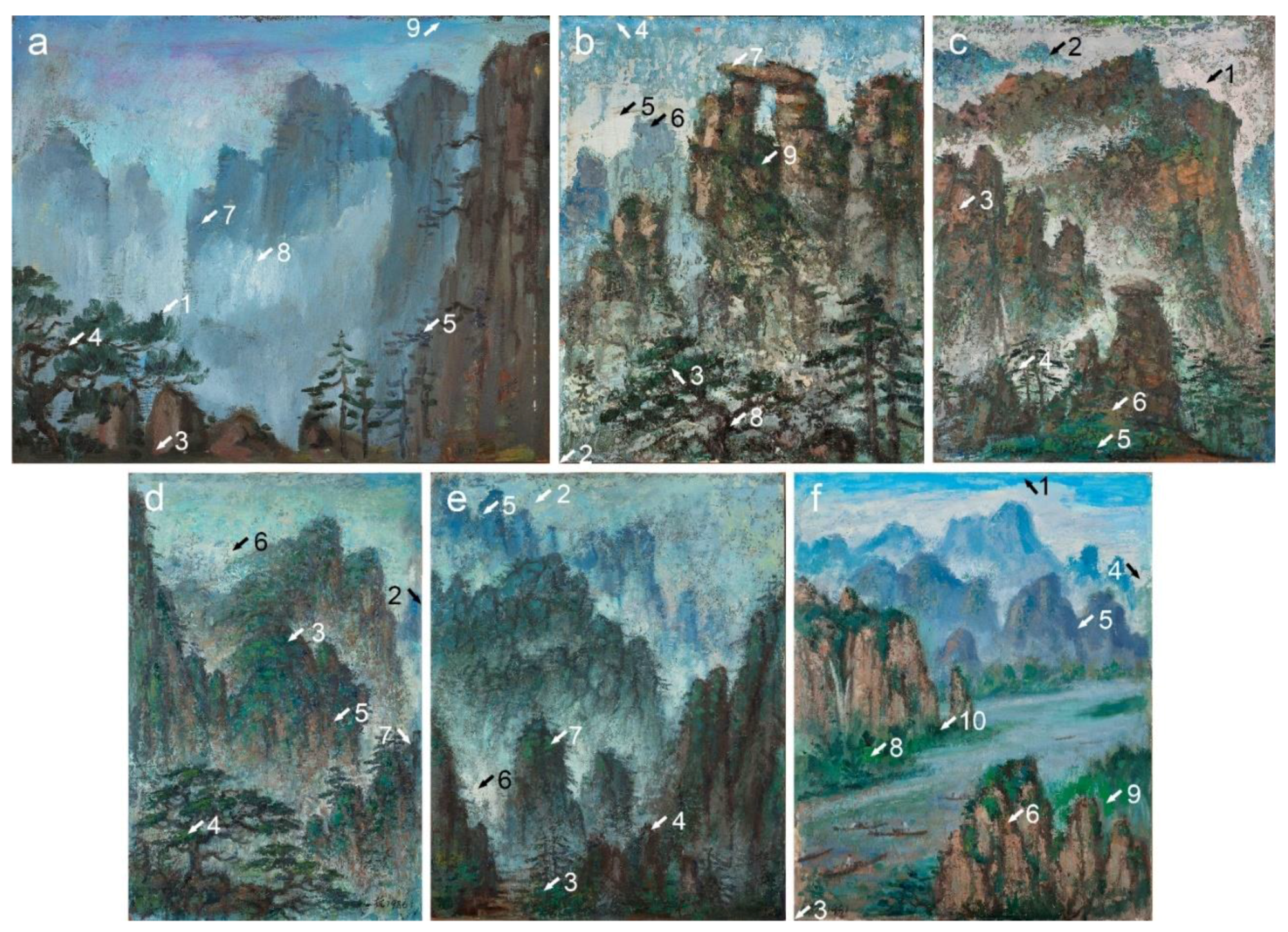

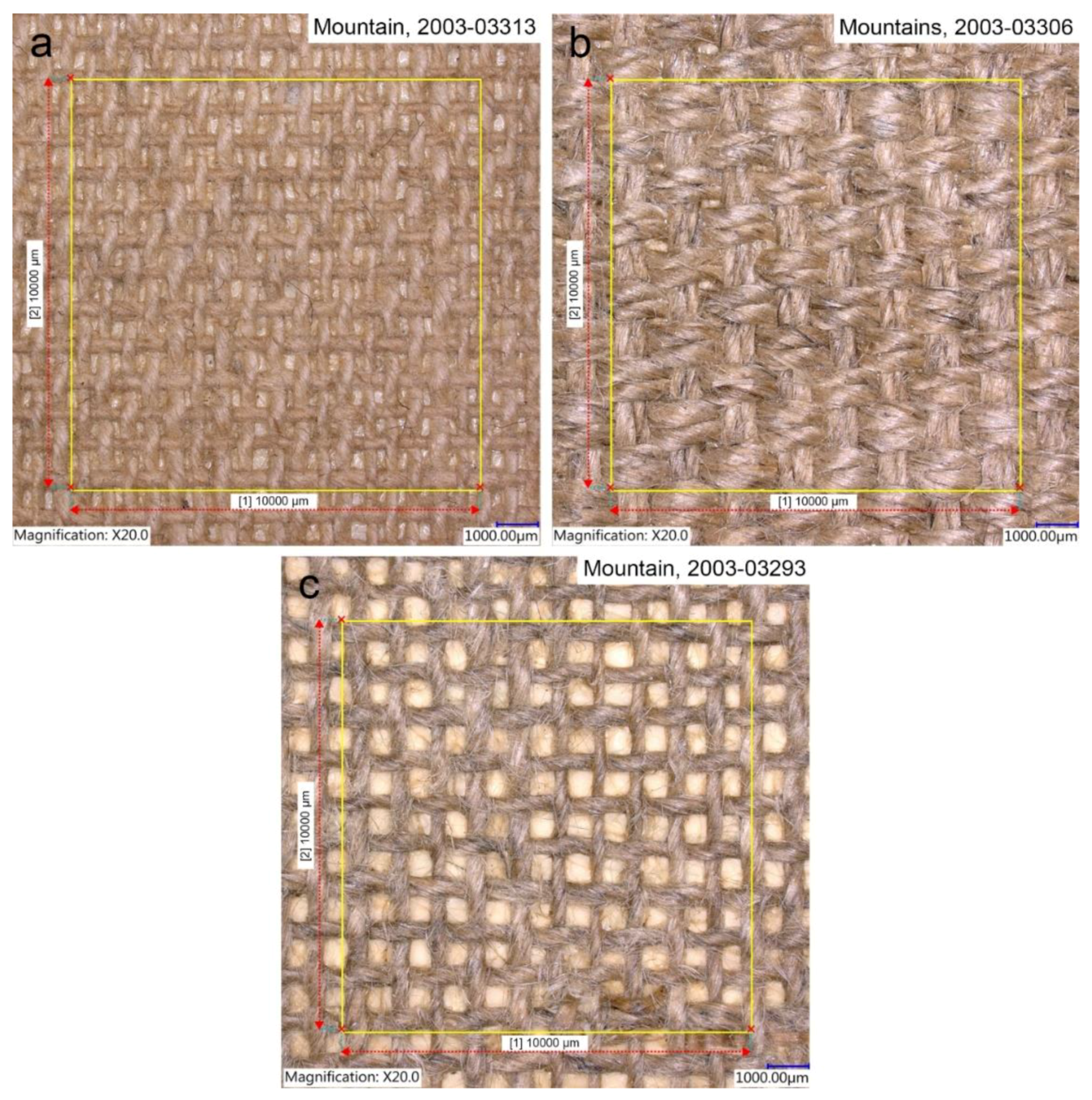


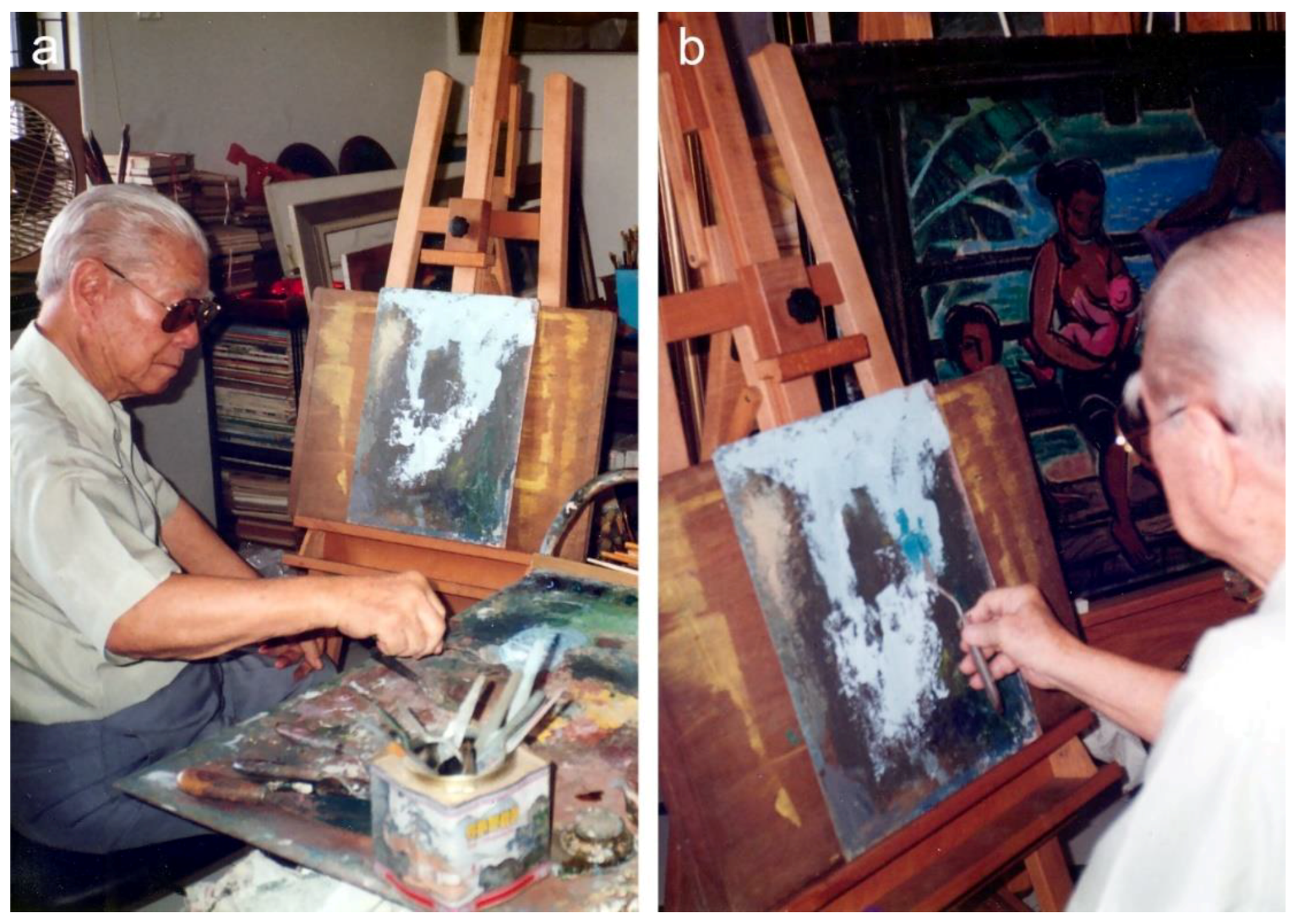

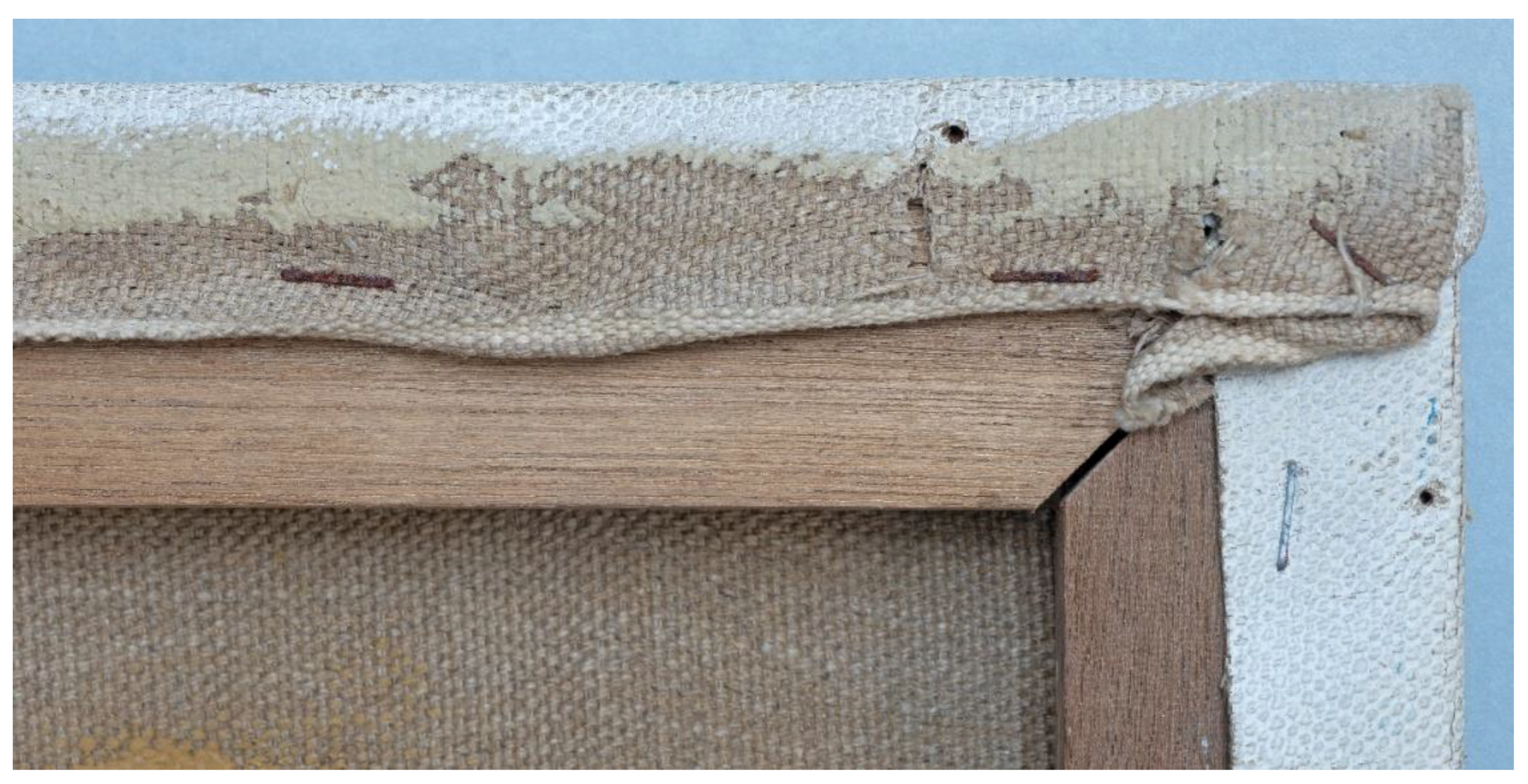

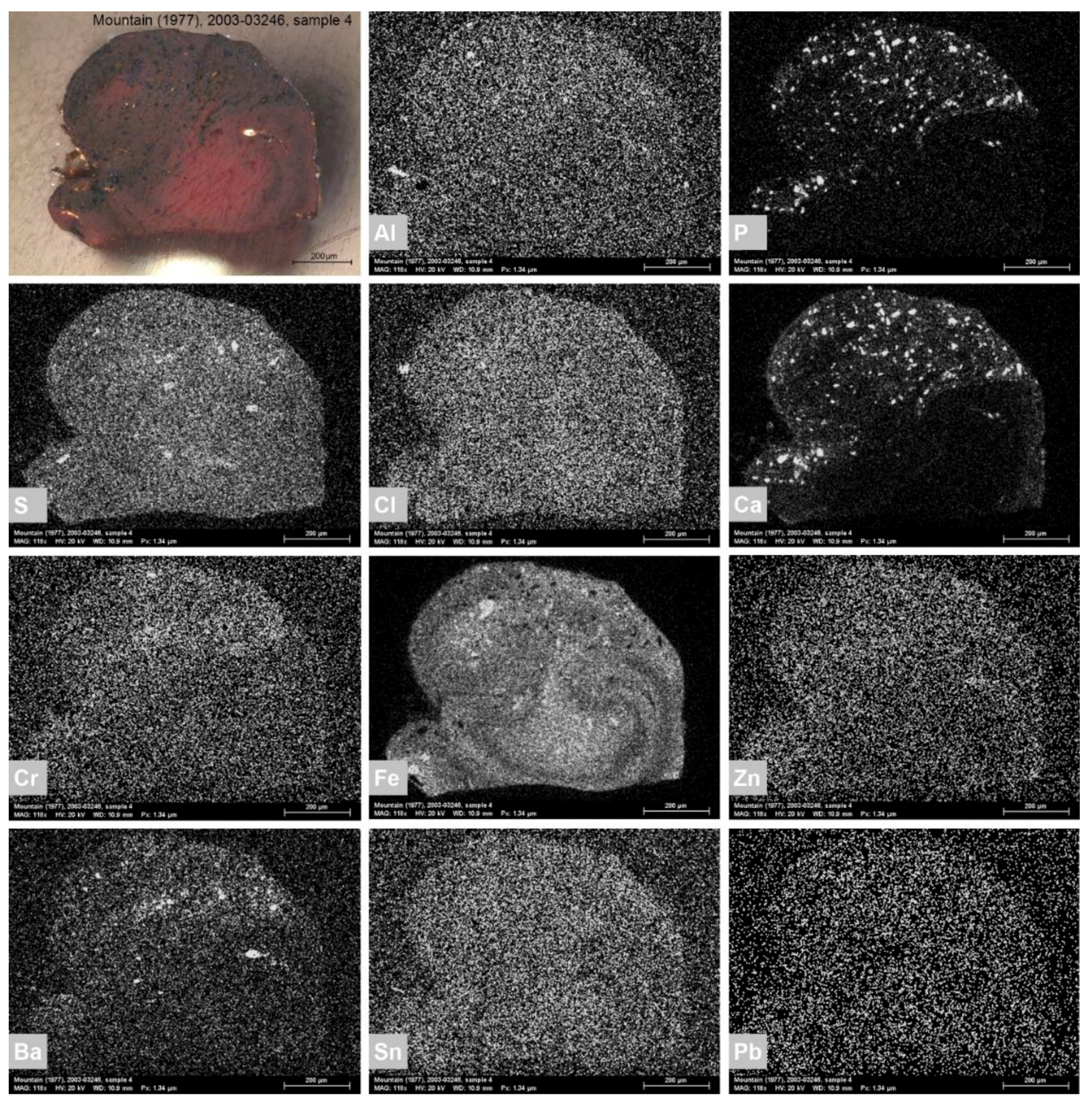
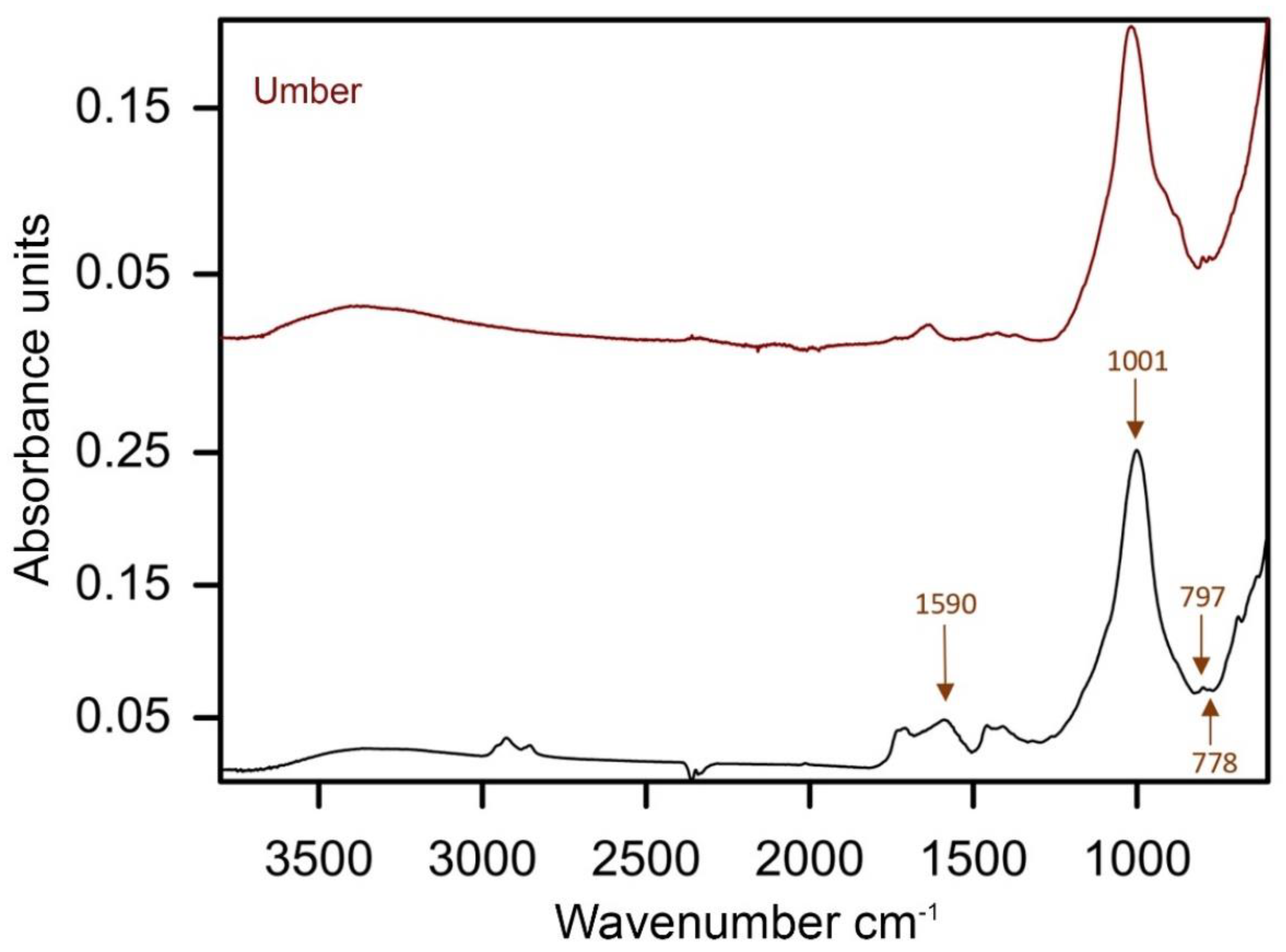
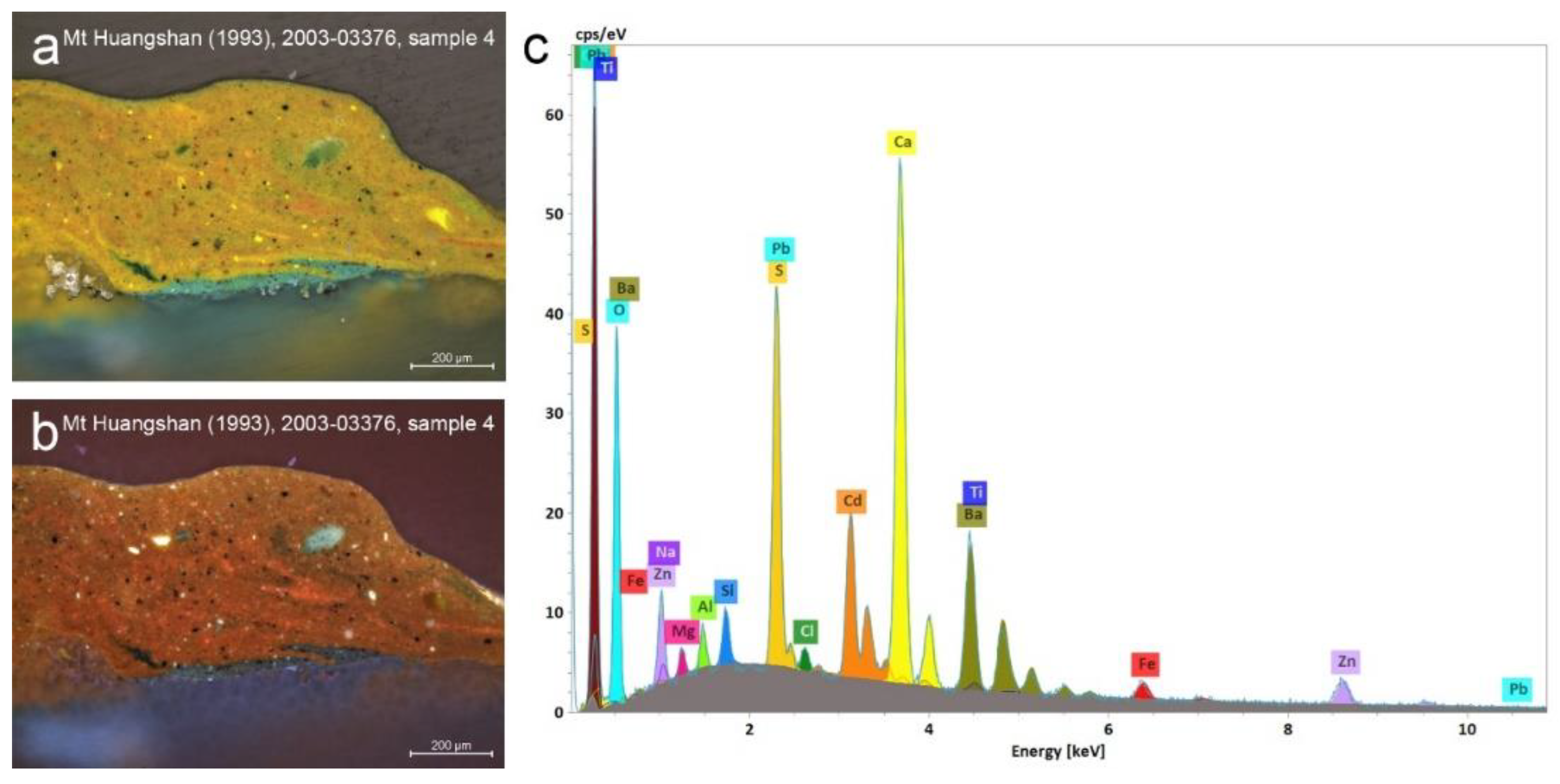
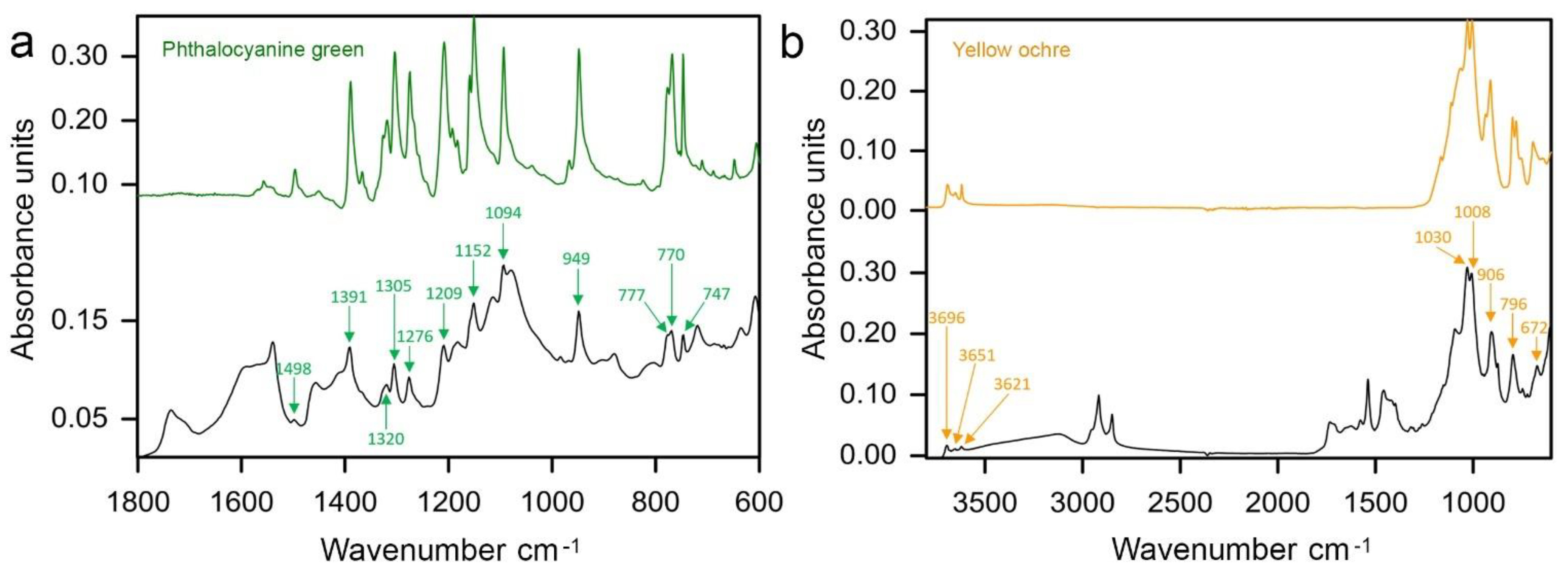
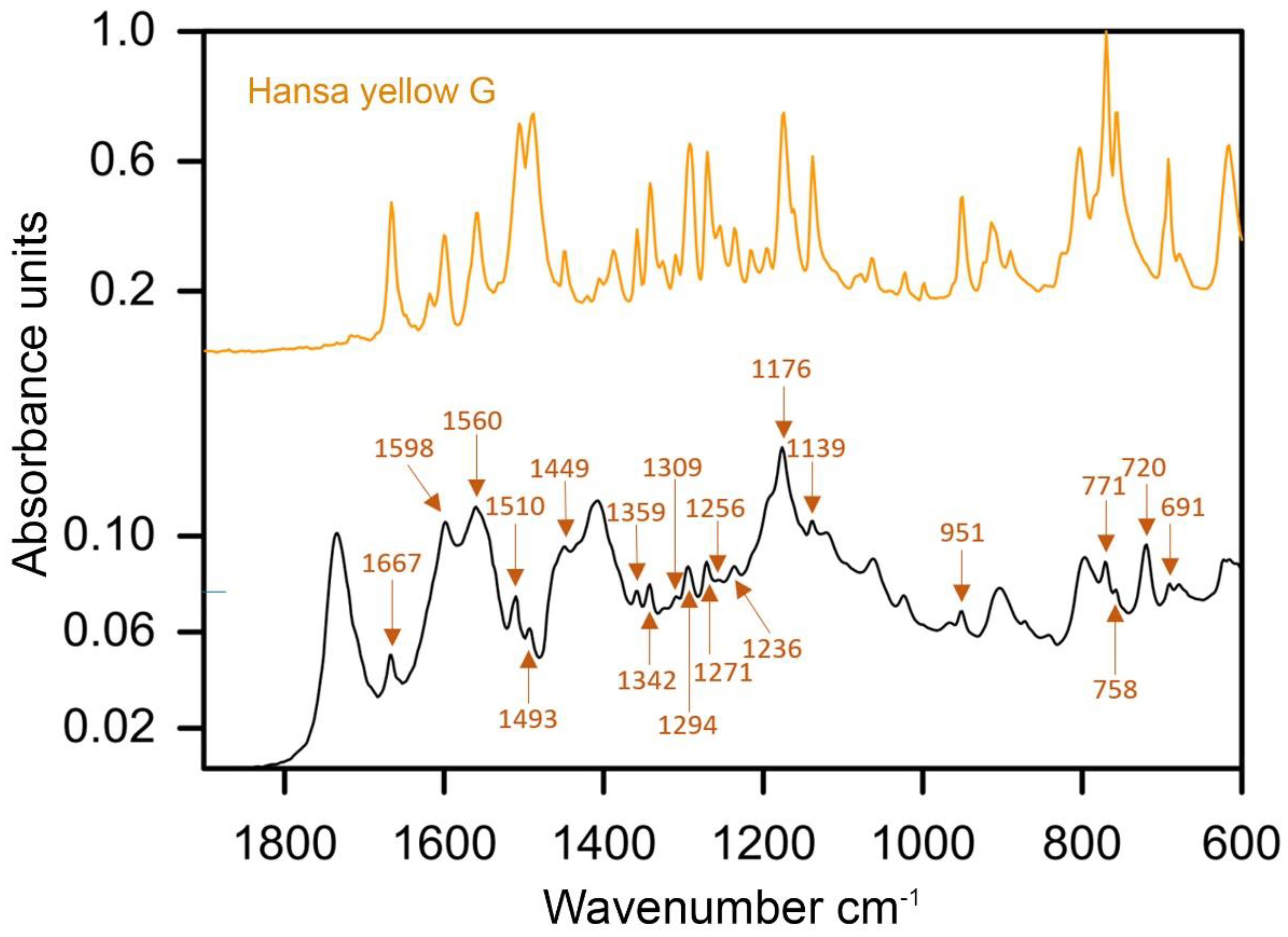

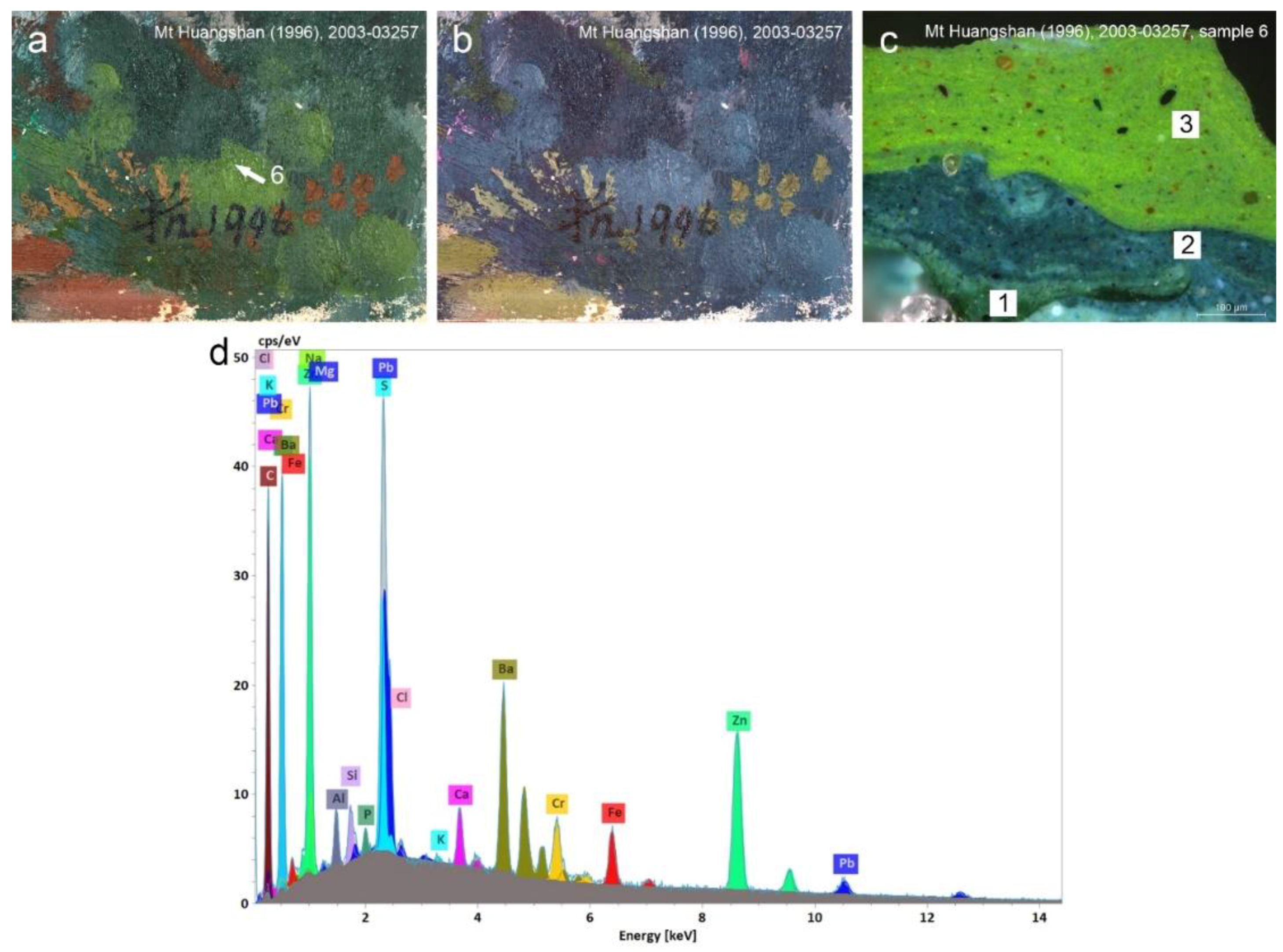
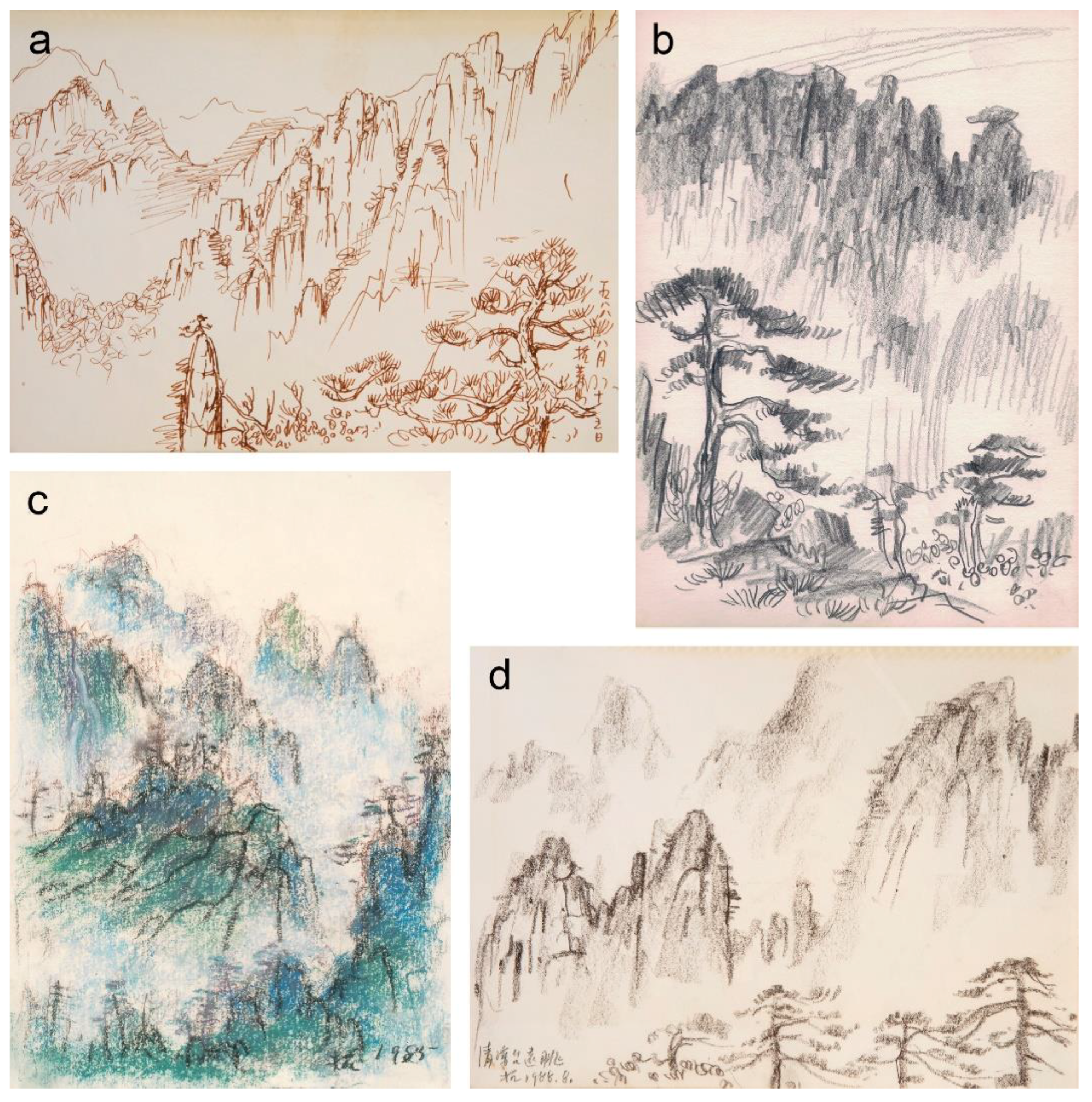
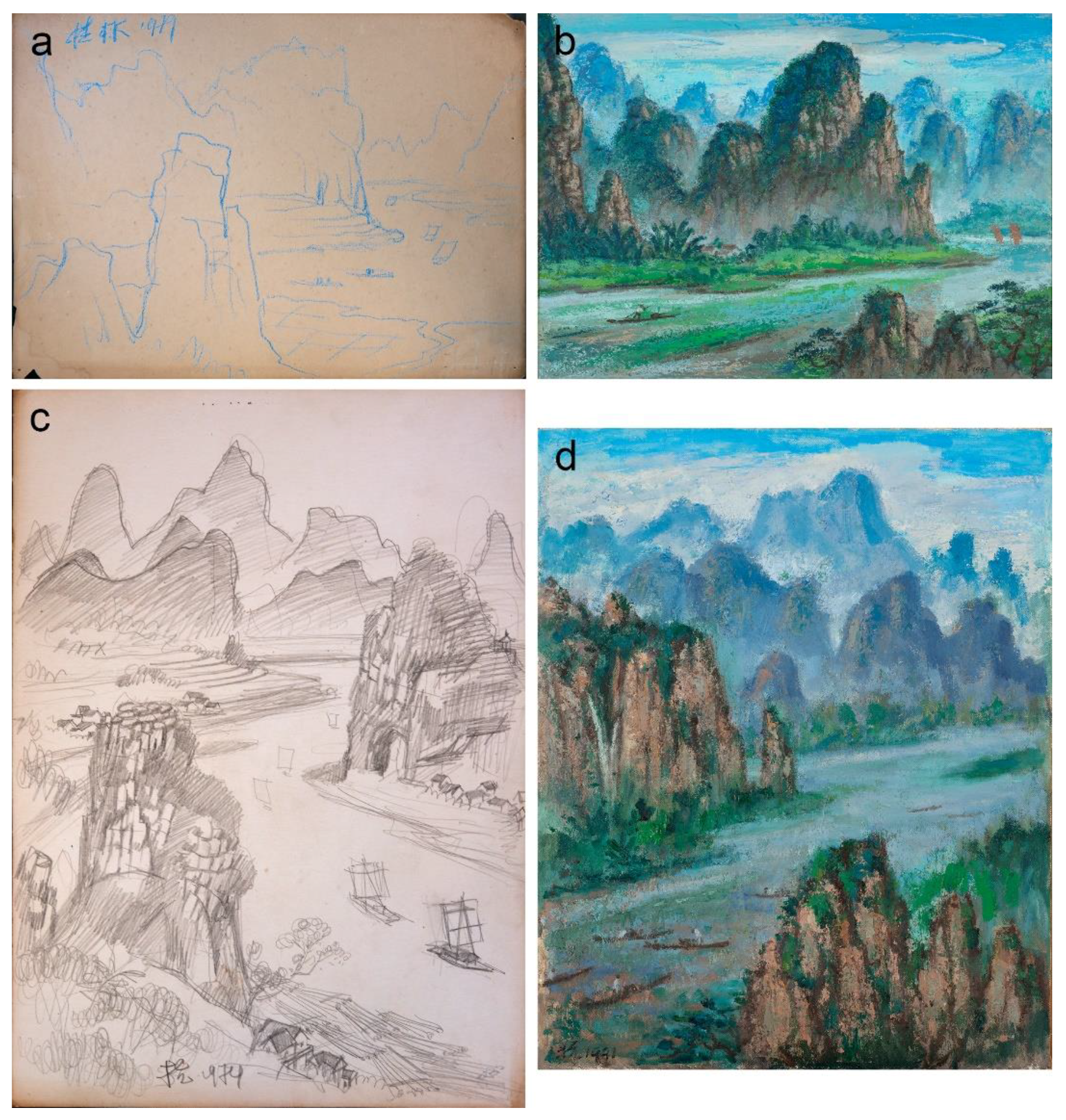
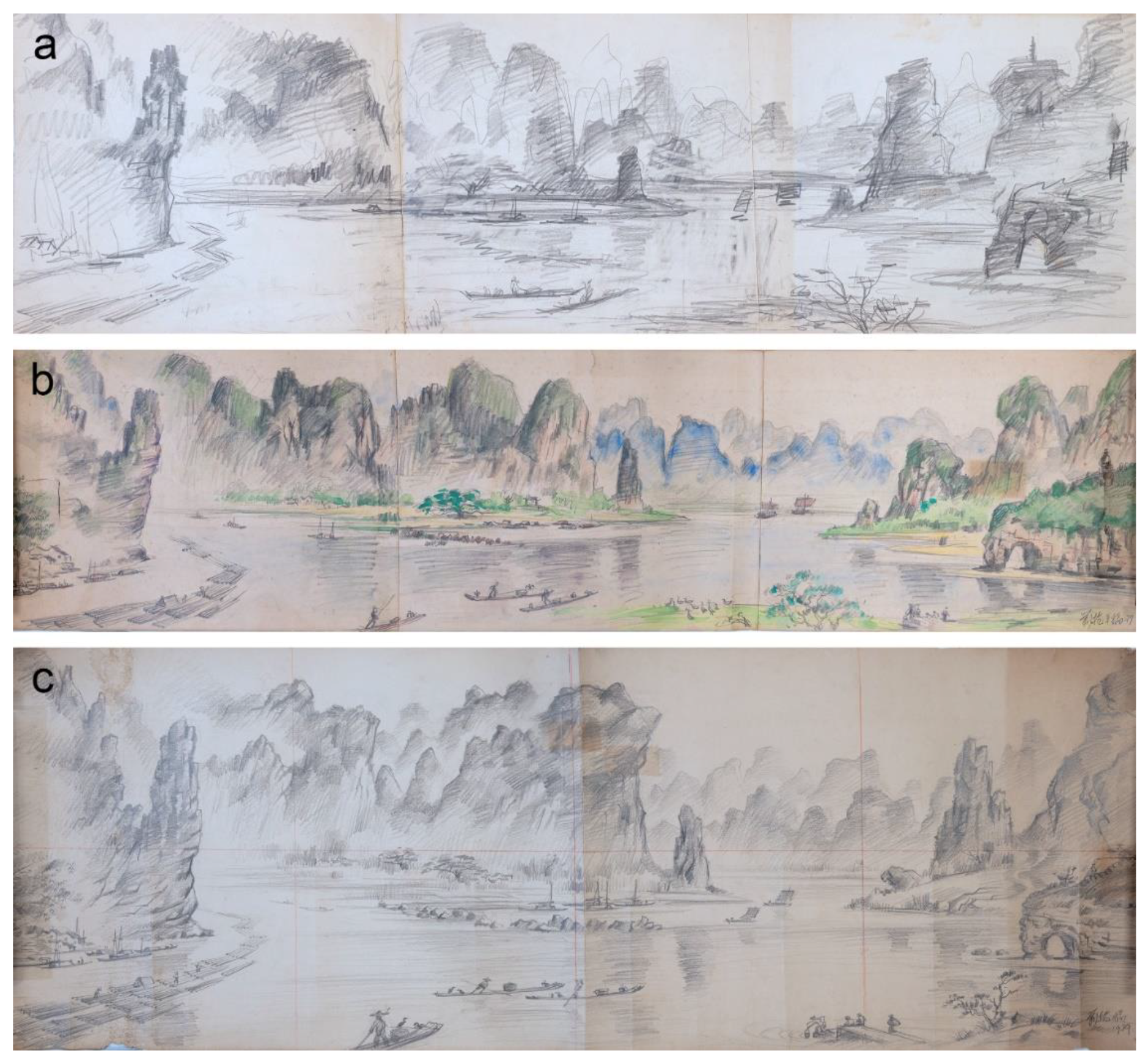
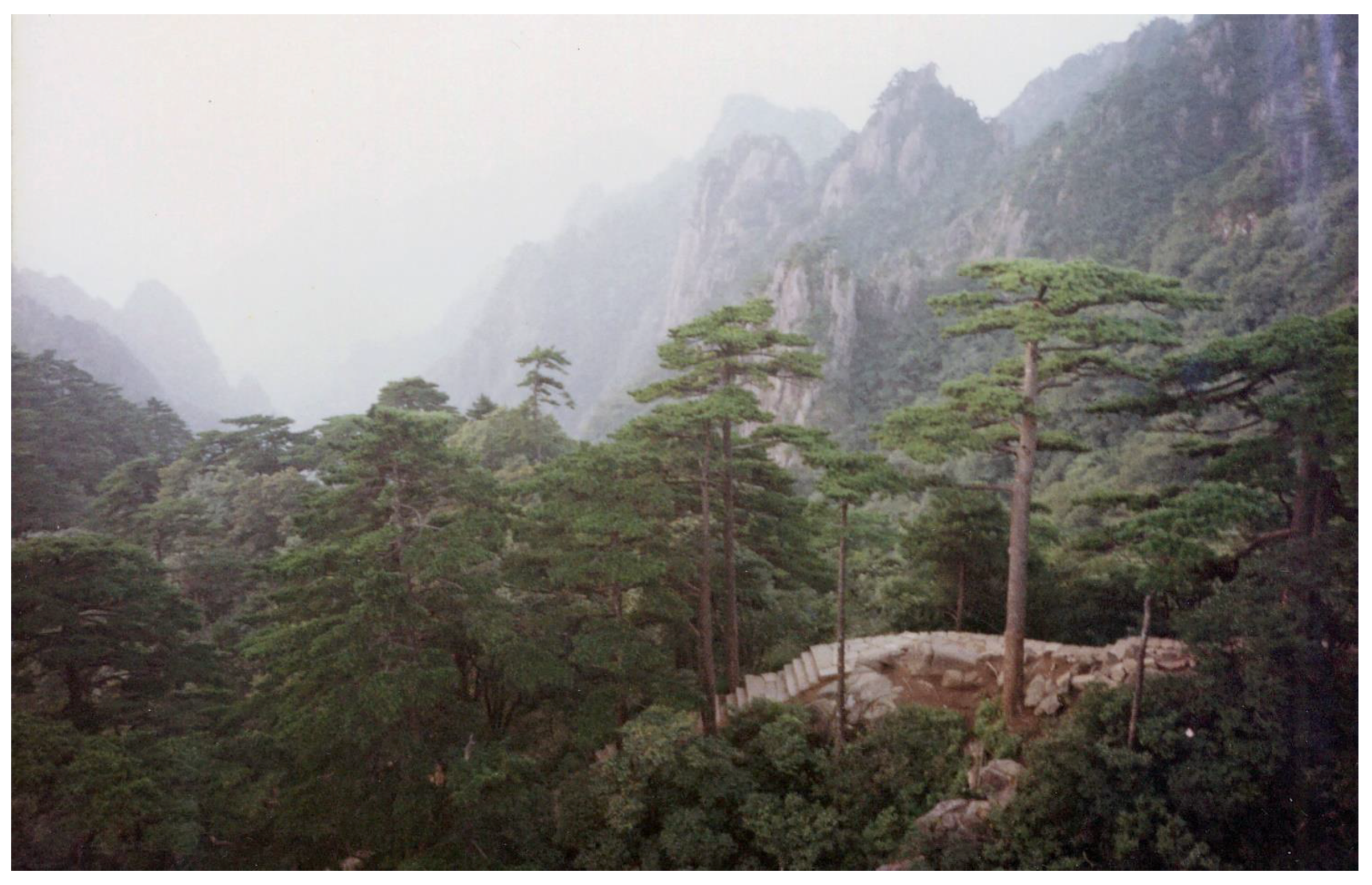
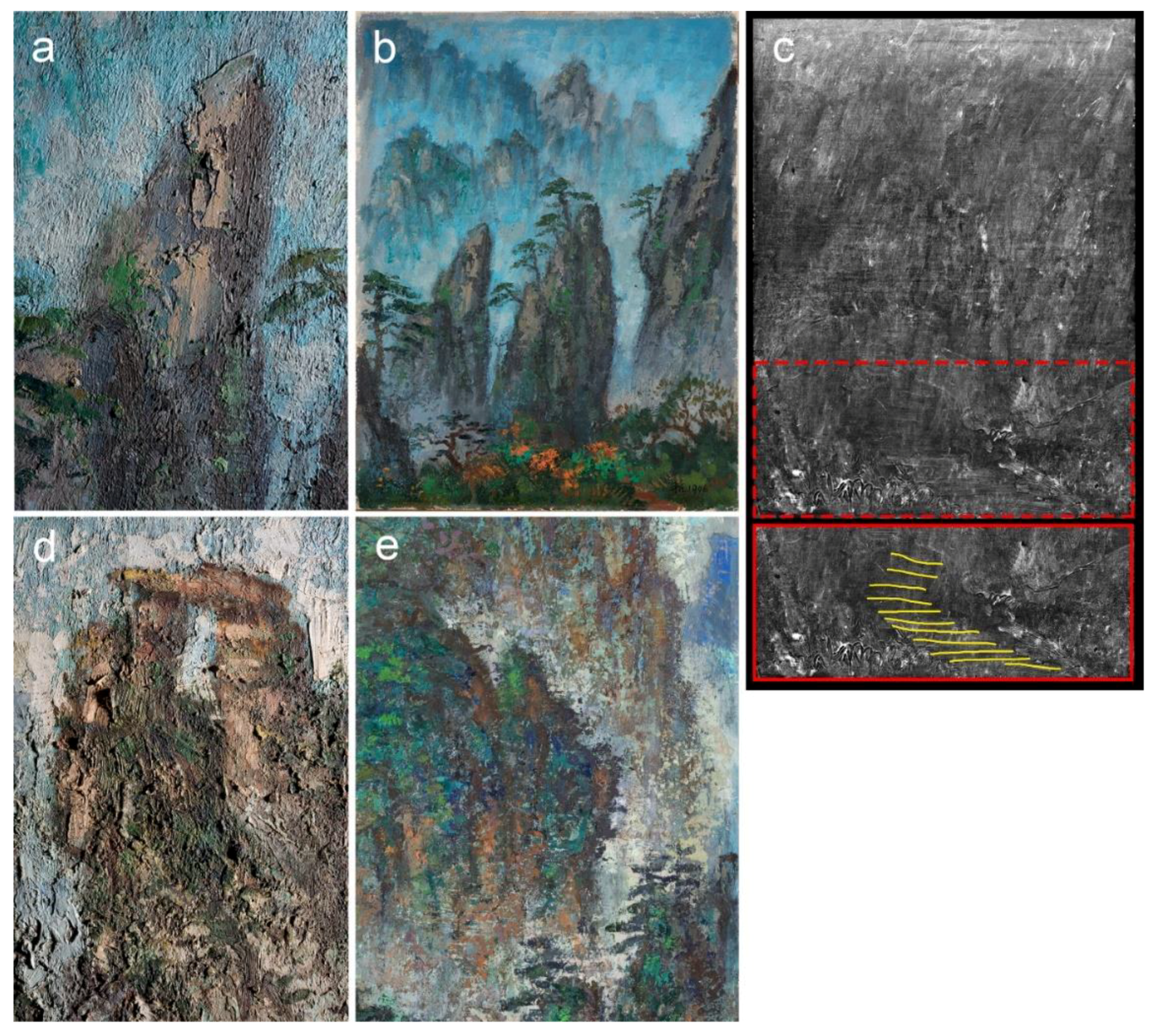

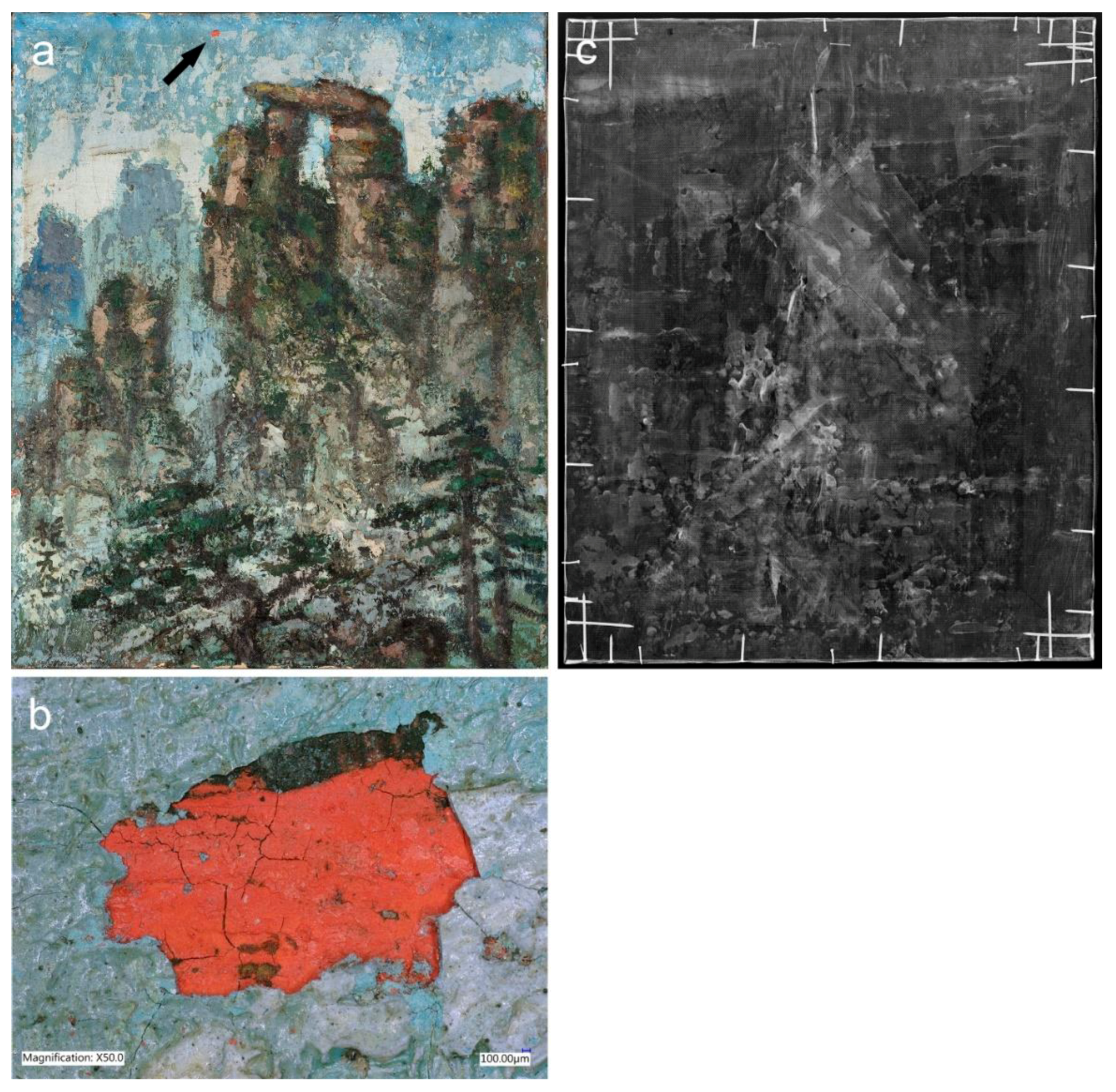
| Title and Inventory Number | Date | Dimensions H × W (cm) | Primary Support | Auxiliary Support |
|---|---|---|---|---|
| Mountain, 2003-03246 | 1977 | 38 × 45.5 | Board | |
| Mountain, 2003-03313 | 1981 | 36 × 29.5 | Canvas | Strainer |
| Mount Huangshan, 2003-03304 | 1983 | 84.6 × 64.5 | Board | |
| Mount Huangshan, 2003-03327 | 1986 | 74 × 48.5 | Board | |
| Mount Huangshan, 2003-03251 | 1987 | 71 × 55.6 | Board | |
| Mountains, 2003-03306 | 1991 | 76.5 × 61 | Canvas | Strainer |
| Mount Huangshan, 2003-03376 | 1993 | 40.5 × 31.7 | Board | |
| Mount Huangshan, 2003-03307 | 1994 | 78.5 × 58.3 | Board | |
| Mount Huangshan, 2003-03378 | 1995 | 30.5 × 40.5 | Board | |
| Mountain, 2003-03293 | 1995 | 84.7 × 118.5 | Canvas | Strainer |
| Mount Huangshan, 2003-03257 | 1996 | 64 × 49 | Canvas | Board |
| Title and Inventory Number | Date | Average Thread Count/cm | Weave | Direction of Warp | Twist | Fibre | Weave Matching Group |
|---|---|---|---|---|---|---|---|
| Mountain, 2003-03313 | 1981 | 17 × 12 | Plain | Vertical | S (warp) Z (weft) | Cotton | 1 |
| Mountains, 2003-03306 | 1991 | 8 × 10 | Basket | Horizontal | Z | Linen | 2 |
| Mountain, 2003-03293 | 1995 | 10 × 10 | Plain | Vertical | Z | Linen | 3 |
| Mount Huangshan, 2003-03257 | 1996 | 17 × 12 | Plain | Vertical | S (warp) Z (weft) | Cotton | 1 |
| Title and Inventory Number | Date | Sample, Layer Number | SEM-EDS Detected Elements * | FTIR Identification | Result | Type of Ground |
|---|---|---|---|---|---|---|
| Mountain, 2003-03313 | 1981 | 2, 1 | Ba, O, C, Zn, Pb, S, Si, (Na, Sr, Al) | Lithopone and/or barium white and zinc white, lead white, zinc soap, oil | Lithopone and/or barium white and zinc white, lead white | 1 |
| Mountains, 2003-03306 | 1991 | 3, 2 | C, O, Pb, Ba, Ti, Zn, S, Ca, (Na, Si, Al) | Chalk, lithopone and/or barium white and zinc white, oil | Lead white, lithopone and/or barium white and zinc white, titanium white, chalk | 2 |
| 3, 1 | O, C, Ca, Zn, (Pb, Na, Si, Ba, Ti, S, Al) | Chalk, zinc soap, oil | Chalk, lithopone and/or barium white and zinc white, lead white, titanium white | |||
| Mountain, 2003-03293 | 1995 | 2, 2 | C, O, Ti, Pb, Ba, Zn, S, Ca, Na, (Al, Si, Cl) | Lithopone and/or barium white and zinc white, lead white, oil | Titanium white, lead white, lithopone and/or barium white and zinc white, chalk | 2 |
| 2, 1 | O, Ca, C, Zn, Pb, (Ba, Na, Ti, Si, Al, S, Cl) | Chalk, lithopone and/or barium white and zinc white, oil | Chalk, lithopone and/or barium white and zinc white, lead white, titanium white | |||
| Mount Huangshan, 2003-03257 | 1996 | 1, 1 | C, O, Zn, Ba, S, Na, (Si, Cl, Al, P, Pb) | Lithopone and/or barium white and zinc white, zinc soap, oil | Lithopone and/or barium white and zinc white, lead white | 1 |
Publisher’s Note: MDPI stays neutral with regard to jurisdictional claims in published maps and institutional affiliations. |
© 2022 by the authors. Licensee MDPI, Basel, Switzerland. This article is an open access article distributed under the terms and conditions of the Creative Commons Attribution (CC BY) license (https://creativecommons.org/licenses/by/4.0/).
Share and Cite
Lizun, D.; Kurkiewicz, T.; Szczupak, B.; Rogóż, J. Painting Materials and Technique for the Expression of Chinese Inheritance in Liu Kang’s Huangshan and Guilin Landscapes (1977–1996). Materials 2022, 15, 7481. https://doi.org/10.3390/ma15217481
Lizun D, Kurkiewicz T, Szczupak B, Rogóż J. Painting Materials and Technique for the Expression of Chinese Inheritance in Liu Kang’s Huangshan and Guilin Landscapes (1977–1996). Materials. 2022; 15(21):7481. https://doi.org/10.3390/ma15217481
Chicago/Turabian StyleLizun, Damian, Teresa Kurkiewicz, Bogusław Szczupak, and Jarosław Rogóż. 2022. "Painting Materials and Technique for the Expression of Chinese Inheritance in Liu Kang’s Huangshan and Guilin Landscapes (1977–1996)" Materials 15, no. 21: 7481. https://doi.org/10.3390/ma15217481
APA StyleLizun, D., Kurkiewicz, T., Szczupak, B., & Rogóż, J. (2022). Painting Materials and Technique for the Expression of Chinese Inheritance in Liu Kang’s Huangshan and Guilin Landscapes (1977–1996). Materials, 15(21), 7481. https://doi.org/10.3390/ma15217481








